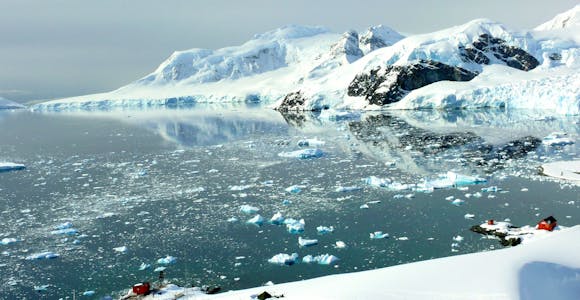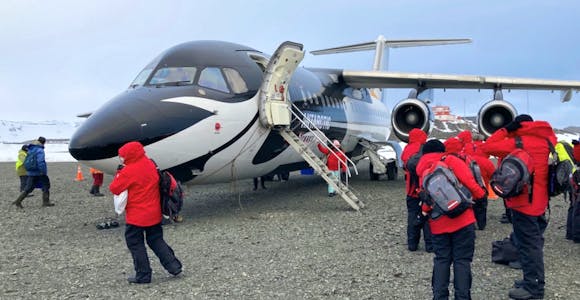
Antarctic Peninsula Cruises
The Peninsula is the classic way to experience Antarctica. Some of the best wildlife and most dramatic scenery can be found in this part of the Frozen Continent.
Discover MoreThe Drake Passage is the stretch of water that lies between the tip of South America and the Antarctic Peninsula. The Southern Ocean’s powerful Antarctic Circumpolar Current has to squeeze through this narrow 500 mile (800 km) gap, creating the potential for strong winds and big waves.
Crossing the Drake offers great wildlife watching opportunities. Albatrosses, petrels, prions and other seabirds follow the ship, and there is the possibility of spotting whales and dolphins. Expedition guides give lectures through the crossing to prepare you for Antarctica – an arrival that’s heralded by spotting your first icebergs on the final stretch of the Drake.

Travellers love to talk about (or worry about) how rough the Drake Passage can be. The famous Drake Shake happens when wind and waves combine to produce swells of 8 metres or more, which is more than enough to cause discomfort.
In fact, fewer than one in four crossings experience such conditions. The vast majority of travellers actually encounter a Drake Lake with small swells and soft winds. In such conditions, the Drake Passage is a truly wonderful place, watching albatrosses on the deck and building the excitement for your arrival in Antarctica.
Whatever the conditions, modern navigation systems allow the ship’s captain to plot the smoothest course across the Drake.


Seasickness can be a problem for some even on relatively calm seas, while others can happily walk the decks of a rolling ship. If you think you may be prone to seasickness, there are plenty of tablets, patches and wristbands available to reduce its effects. Take time before travelling to talk to a doctor or pharmacist to find the best option for you. All ships have an onboard doctor who will be able to help during the voyage.
During the Drake Passage, it’s important to stay hydrated and eat lightly. Rest also helps: seasickness tablets can cause drowsiness, so embracing the power nap can be a very useful option while at sea.
If sea sickness is a real problem, consider avoiding the Drake with a Fly and Cruise trip.
Modern expedition cruise ships are well equipped to tackle the Drake Passage. Almost all have underwater stabilisers toreduce the rocking and rolling on heavy seas. Those looking to take this further can consider a ship with a X-Bow design, which have hulls designed to better slice through the waves.
If you anticipate lots of cabin time due to seasickness concerns, booking one with floor to ceiling windows or a balcony, as enjoying a view to the horizon is helpful when dealing with lots of motion.

For those who are short on time or worried about their sea legs, it’s possible to bypass the Drake Passage entirely by flying direct to Antarctica. Fly & Cruise trips whisk you from Punta Arena in Chile to the South Shetland Islands in just two hours, where you’ll board your expedition cruise ship and be ready to spot your first penguin in no time.
Operational logistics means that Fly & Cruise trips cost slightly more than sailing across the Drake Passage, but they’re perfect for those who want to get straight into the action.

Price Match Promise - We’ll match any price you find elsewhere for the same trip
Swoop has catered for travellers of every group size. Whether you’re adventuring solo or bringing a group of over 100. We can help.
Under normal weather conditions, it takes around 48 hours to sail across the Drake Passage, though crossings can occasionally take longer. Your ship's captain will be constantly monitoring the wind and wave conditions to ensure you have the fastest (and smoothest) passage possible.
The majority of Drake Passage crossings are smooth. As a general rule, fewer than one in four result in a 'Drake Shake' with big waves.
Almost all modern expedition cruise ships are equipped with underwater stabilisers to reduce the effects of the waves. Those with the most recent X-Bow design further smooth the ship's passage – although it should be noted that it is never possible to entirely counter the effects of a big sea.
The time spent crossing the Drake Passage is a brilliant way to build anticipation for Antarctica.
Wildlife watching begins the moment you start to cross the Drake, with albatrosses and other seabirds as your constant companions on the Southern Ocean. In addition, expedition guides give a series of lectures and talks during the crossing to prepare you for what you'll experience in Antarctica and get you even more excited for the 7th Continent. The two day crossing can pass surprisingly quickly: you certainly won't be bored.
On the return voyage, many people enjoy the slow crossing as a time to decompress and process their polar experience with newfound friends – as well as sorting through the thousands of photos they've taken during the trip.
Yes. The ship's doctor will have plenty of experience dealing with seasickness and may be able to prescribe you preventive drugs if necessary. In addition, they often give a briefing at the start of the voyage on the best ways to prevent and treat seasickness.
Please note that some specific drugs or other treatments like pressure patches may not be available on board. If you think you may be prone to seasickness, it's always best to consult your doctor before you travel and bring any treatments with you.
Conditions on the Drake Passage are pretty constant throughout the Antarctic cruising season, so there is no 'best' time to cross it. This means you can concentrate on choosing your trip based on the other experiences you want to have, whether that’s focused on wildlife-watching, photography or adventure activities.
For more information see our page on the best time to visit Antarctica.

The Peninsula is the classic way to experience Antarctica. Some of the best wildlife and most dramatic scenery can be found in this part of the Frozen Continent.
Discover More
Fly & Cruise trips offer the best of Antarctica in one simple package: flying to the Peninsula in two hours to join an expedition cruise ship for a classic polar adventure.
Discover More
We work with a range of different Antarctic vessels, with expertise across the entire polar fleet, to give you the best choice of ship, cabin and departure date.
Discover More
Choosing when to go to Antarctica is a key part of planning a cruise, with each month of the season offering a different side of the continent.
Discover MoreWe'll spend some time listening to your aspirations, then discuss the kind of experience that might suit you.
Next we'll discuss the options, shortlist the best trips for you and present you our impartial recommendations.
We'll place a 24 hour hold on your preferred option - without obligation - whilst we talk through the details.
With over 100 years of Antarctic experience between us, we can help guide you to exactly the right trip for you.
1 888 970 4570